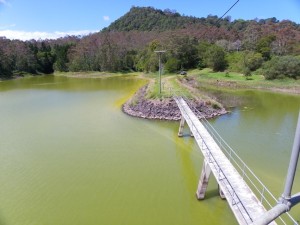
On only a very few occasions since the dam’s construction in 1988 has the water level of Lake Baroon fallen below 70% capacity, presently at 64.8% full as a result of below average rainfall over the catchment in the past several months. The most recent example is February, where just 60mm fell in the Maleny region – a far cry from the average February rainfall of 335mm in the region. February 2003 was the last time the water had fallen this low, however at the time Lake Baroon wasn’t also supplying water to the northern suburbs of Brisbane via the Northern Pipeline Interconnector. This pipeline is presently carrying 3 megalitres (3,000,000 litres) daily from the dam, but this volume of water will be reduced if/when the dam drops below 60%.

As a consequence of such low rainfall there is an increased presence of blue-green algae, a naturally occurring organism (technically not algae, but cyanobacteria) that lives in rivers, lakes and waterways. During these dry conditions, the algae grow rapidly and can become a dominating and sometimes toxic, nuisance. Due to the potential health risk posed by large amounts of blue-green algae, Lake Baroon has been closed for en extended period to water-based activities. The algae isn’t always as visible as the picture to the left shows, but will be present in small chunks throughout the water column.
 Another aspect of the receding water level are rarely seen dead tree stumps, mostly submerged for the 25 years following the dam’s construction. Catfish nests are also visible in the silt-laden, now-exposed shore of the dam, as was a single diving flipper and sunglasses – raising all sorts of suggestions.
Another aspect of the receding water level are rarely seen dead tree stumps, mostly submerged for the 25 years following the dam’s construction. Catfish nests are also visible in the silt-laden, now-exposed shore of the dam, as was a single diving flipper and sunglasses – raising all sorts of suggestions.
UPDATE: In the last 24 hours to 9am on Friday, 29th March, 250mm of rain has been recorded at Lake Baroon, raising the dam level to 74.2% capacity (as of 9am, 28th March). As a result, good flows into the dam are expected, further raising the water level.




